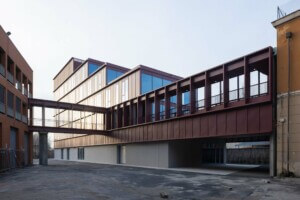It’s easy to get overwhelmed at the Salone del Mobile and the dozens of related events during Milan Design Week. Luckily there are plenty of visual palate cleansers in form of immersive environments, from new showrooms by Pritzker Prize–winning architects to dazzling installations by up-and-coming designers. There is more to Milan Design Week than just great looking furniture! At the Triennale design museum, for instance, Paris-based DGT architects created a light-catching installation for Citizen watches called Light is Time (above), featuring space dividing curtains made of tens of thousands of watch plates.
For the Swedish textile company Kinnasand, a division of Kvadrat, Toyo Ito designed a luminous new showroom to display the company’s fabrics, many of which feature diaphanous qualities. Ito covered the walls in frosted glass, which gives them a shimmering quality as downlights tucked into the edge of the ceiling filter through the panels. The ceiling itself is paneled in reflective metal. Draped fabrics are displayed on curved metal rods suspended from the ceiling.
Cassina tapped the rising Japanese star Sou Fujimoto to design a “floating forest” for their booth at the fairgrounds, arguably the most innovative display at the Salone. Fujimoto hung mirrored metal planters from the rafters, which held green Japanese maples. Canned bird noises added to the atmosphere, which felt both natural and surreal within the tradeshow hall. The reflective surfaces forced visitors to slow down within the booth, giving them more time to look at Cassina’s classic and contemporary furnishings.
Also at the fairgrounds, an invited group of architects—Shigeru Ban, Mario Bellini, David Chipperfield, Massimiliano and Doriana Fuksas, Zaha Hadid, Marcio Kogan, Daniel Libeskind, and Studio Mumbai—riffed on themes of domesticity with conceptual installations called, Where Architects Live.
As far as installations like these at a furniture fair go, the installations were largely devoid of the trappings of daily life. Libeskind, for example, sliced deep voids into the walls, inset with screens showing videos about his personal history and architectural projects. Chipperfield showed of his German side, with photos of deliciously drab Berlin and clanging music underscoring the seriousness of the project.










